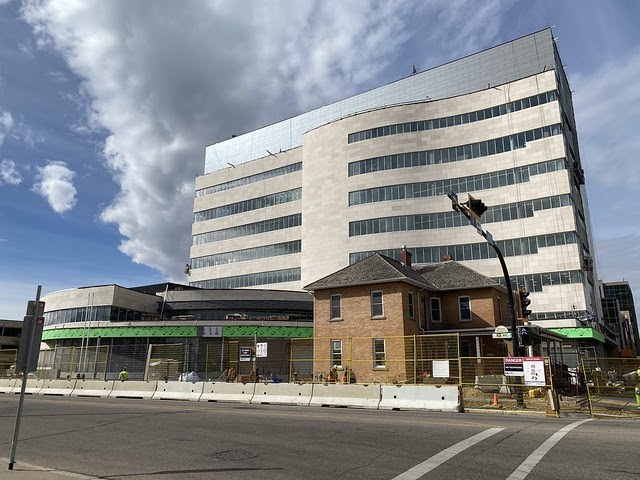Alberta
Red Deer Justice Centre looking to add courtroom space as construction nears completion

Construction of the new Red Deer Justice Centre is nearing completion.
Alberta’s government is investing in courthouse infrastructure to provide Albertans with courthouses that are modern, safe and easy to access.
Upgrading and building new courthouses improves Albertans’ access to the justice system by adding courtrooms and making buildings easier for everyone to navigate. Red Deer is getting a new building with additional courtrooms while Brooks, Hinton and Peace River will see renovations to the existing courthouses to make them more user-friendly and to provide updated security, privacy and accessibility features.
Red Deer Justice Centre
With an investment of more than $200 million, construction of the new Red Deer Justice Centre is nearing completion. Once finished, it will have 12 courtrooms ready for use, an increase from eight at the current facility. This will allow more cases to be heard at one time so matters can proceed in a timely manner. A $200,000 investment in Budget 2023 will support a planning study to build out four additional courtrooms, which, when complete, will bring the total number of courtrooms to 16.
The justice centre will also have spaces for people taking alternative approaches to the traditional courtroom trial process, with three new suites for judicial dispute resolution services, a new Indigenous courtroom with dedicated venting for smudging purposes, and a dedicated suite for alternative dispute resolution services such as family mediation and civil mediation.
Albertans continue to access court services at the existing Red Deer courthouse while the new centre is being built.
“Upgrading our province’s courthouses gives Albertans a more secure and comfortable experience when they need to visit court. By building a new justice centre in Red Deer, we are taking steps to increase capacity in the justice system to keep up with demand.”
Brooks courthouse
The upgraded Brooks courthouse is fully operational, as renovations were completed in August. A $4.6-million investment by Alberta’s government enabled many improvements to the courthouse, including a new public waiting area, vulnerable witness room, holding cells, prisoner dock and other updates. Alberta’s government is also investing in upgrades to courtroom audiovisual equipment at the Brooks courthouse.
“Access to justice services within communities across Alberta is critically important. Not only will these projects help increase access to the judicial system, boost the local economy and create jobs, they will also ensure effective and accessible delivery of services Albertans rely on.”
Hinton courthouse
Alberta’s government has invested $2.7 million for accessibility improvements to the Hinton courthouse. Improvements include wider entrances and more accessible handicap buttons at the main entrance and public washrooms, and more space at security screening areas. Renovations began in July and are expected to be complete by the end of the year. In the meantime, Albertans are accessing court services at the nearby Pembina Place building.
“The Canadian Bar Association – Alberta Branch has long been calling for upgrades to Alberta’s court infrastructure through our Agenda for Justice, including improving courtroom technology to make virtual appearances more widely available, improving physical accessibility to ensure that all Albertans can safely access court facilities, and improving capacity to address our province’s growing population. We are pleased to see these improvements underway, and look forward to continued investments in Alberta’s court infrastructure and modernization.”
Peace River courthouse
To increase accessibility, Alberta’s government is providing $250,000 for a barrier-free access project at the courthouse in Peace River. Operations are expected to continue without disruption during renovations, which will begin next month.
Alberta
Housing in Calgary and Edmonton remains expensive but more affordable than other cities

From the Fraser Institute
By Tegan Hill and Austin Thompson
In cities across the country, modest homes have become unaffordable for typical families. Calgary and Edmonton have not been immune to this trend, but they’ve weathered it better than most—largely by making it easier to build homes.
Specifically, faster permit approvals, lower municipal fees and fewer restrictions on homebuilders have helped both cities maintain an affordability edge in an era of runaway prices. To preserve that edge, they must stick with—and strengthen—their pro-growth approach.
First, the bad news. Buying a home remains a formidable challenge for many families in Calgary and Edmonton.
For example, in 2023 (the latest year of available data), a typical family earning the local median after-tax income—$73,420 in Calgary and $70,650 in Edmonton—had to save the equivalent of 17.5 months of income in Calgary ($107,300) or 12.5 months in Edmonton ($73,820) for a 20 per cent down payment on a typical home (single-detached house, semi-detached unit or condominium).
Even after managing such a substantial down payment, the financial strain would continue. Mortgage payments on the remaining 80 per cent of the home’s price would have required a large—and financially risky—share of the family’s after-tax income: 45.1 per cent in Calgary (about $2,757 per month) and 32.2 per cent in Edmonton (about $1,897 per month).
Clearly, unless the typical family already owns property or receives help from family, buying a typical home is extremely challenging. And yet, housing in Calgary and Edmonton remains far more affordable than in most other Canadian cities.
In 2023, out of 36 major Canadian cities, Edmonton and Calgary ranked 8th and 14th, respectively, for housing affordability (relative to the median after-tax family income). That’s a marked improvement from a decade earlier in 2014 when Edmonton ranked 20th and Calgary ranked 30th. And from 2014 to 2023, Edmonton was one of only four Canadian cities where median after-tax family income grew faster than the price of a typical home (in Calgary, home prices rose faster than incomes but by much less than in most Canadian cities). As a result, in 2023 typical homes in Edmonton cost about half as much (again, relative to the local median after-tax family income) as in mid-sized cities such as Windsor and Kelowna—and roughly one-third as much as in Toronto and Vancouver.
To be clear, much of Calgary and Edmonton’s improved rank in affordability is due to other cities becoming less and less affordable. Indeed, mortgage payments (as a share of local after-tax median income) also increased since 2014 in both Calgary and Edmonton.
But the relative success of Alberta’s two largest cities shows what’s possible when you prioritize homebuilding. Their approach—lower municipal fees, faster permit approvals and fewer building restrictions—has made it easier to build homes and helped contain costs for homebuyers. In fact, homebuilding has been accelerating in Calgary and Edmonton, in contrast to a sharp contraction in Vancouver and Toronto. That’s a boon to Albertans who’ve been spared the worst excesses of the national housing crisis. It’s also a demographic and economic boost for the province as residents from across Canada move to Alberta to take advantage of the housing market—in stark contrast to the experience of British Columbia and Ontario, which are hemorrhaging residents.
Alberta’s big cities have shown that when governments let homebuilders build, families benefit. To keep that advantage, policymakers in Calgary and Edmonton must stay the course.
Alberta
Danielle Smith slams Skate Canada for stopping events in Alberta over ban on men in women’s sports

From LifeSiteNews
The Alberta premier has denounced Skate Canada as ‘disgraceful’ for refusing to host events in the province because of a ban on ‘transgender’ men in women’s sports.
Alberta Premier Danielle Smith has demanded an apology after Skate Canada refused to continue holding events in Alberta.
In a December 16 post on X, Smith denounced Skate Canada’s recent decision to stop holding competitions in Alberta due to a provincial law keeping gender-confused men from competing in women’s sports.
“Women and girls have the right to play competitive sports in a safe and fair environment against other biological females,” Smith declared. “This view is held by a vast majority of Albertans and Canadians. It is also common sense and common decency.”
Women and girls have the right to play competitive sports in a safe and fair environment against other biological females.
This view is held by a vast majority of Albertans and Canadians. It is also common sense and common decency.
Skate Canada‘s refusal to hold events in… pic.twitter.com/n4vbkTx6B0
— Danielle Smith (@ABDanielleSmith) December 16, 2025
“Skate Canada‘s refusal to hold events in Alberta because we choose to protect women and girls in sport is disgraceful,” she declared.
“We expect they will apologize and adjust their policies once they realize they are not only compromising the fairness and safety of their athletes, but are also offside with the international community, including the International Olympic Committee, which is moving in the same direction as Alberta,” Smith continued.
Earlier this week, Skate Canada announced their decision in a statement to CBC News, saying, “Following a careful assessment of Alberta’s Fairness and Safety in Sport Act, Skate Canada has determined that we are unable to host events in the province while maintaining our national standards for safe and inclusive sport.”
Under Alberta’s Fairness and Safety in Sport Act, passed last December, biological men who claim to be women are prevented from competing in women’s sports.
Notably, Skate Canada’s statement failed to address safety and fairness concerns for women who are forced to compete against stronger, and sometimes violent, male competitors who claim to be women.
Under their 2023 policy, Skate Canada states “skaters in domestic events sanctioned by Skate Canada who identify as trans are able to participate in the gender category in which they identify.”
While Skate Canada maintains that gender-confused men should compete against women, the International Olympic Committee is reportedly moving to ban gender-confused men from women’s Olympic sports.
The move comes after studies have repeatedly revealed what almost everyone already knew was true, namely that males have a considerable innate advantage over women in athletics.
Indeed, a recent study published in Sports Medicine found that a year of “transgender” hormone drugs results in “very modest changes” in the inherent strength advantages of men.
Additionally, male athletes competing in women’s sports are known to be violent, especially toward female athletes who oppose their dominance in women’s sports.
Last August, Albertan male powerlifter “Anne” Andres was suspended for six months after a slew of death threats and harassments against his female competitors.
In February, Andres ranted about why men should be able to compete in women’s competitions, calling for “the Ontario lifter” who opposes this, apparently referring to powerlifter April Hutchinson, to “die painfully.”
Interestingly, while Andres was suspended for six months for issuing death threats, Hutchinson was suspended for two years after publicly condemning him for stealing victories from women and then mocking his female competitors on social media. Her suspension was later reduced to a year.
-

 Alberta1 day ago
Alberta1 day agoDanielle Smith slams Skate Canada for stopping events in Alberta over ban on men in women’s sports
-

 International1 day ago
International1 day agoTOTAL AND COMPLETE BLOCKADE: Trump cuts off Venezuela’s oil lifeline
-

 Crime1 day ago
Crime1 day agoThe Uncomfortable Demographics of Islamist Bloodshed—and Why “Islamophobia” Deflection Increases the Threat
-

 COVID-191 day ago
COVID-191 day agoSenator Demands Docs After ‘Blockbuster’ FDA Memo Links Child Deaths To COVID Vaccine
-

 Energy2 days ago
Energy2 days agoLiberals Twisted Themselves Into Pretzels Over Their Own Pipeline MOU
-

 COVID-191 day ago
COVID-191 day agoChina Retaliates Against Missouri With $50 Billion Lawsuit In Escalating Covid Battle
-

 Business13 hours ago
Business13 hours agoCanada Hits the Brakes on Population
-

 International1 day ago
International1 day agoBondi Beach Shows Why Self-Defense Is a Vital Right






